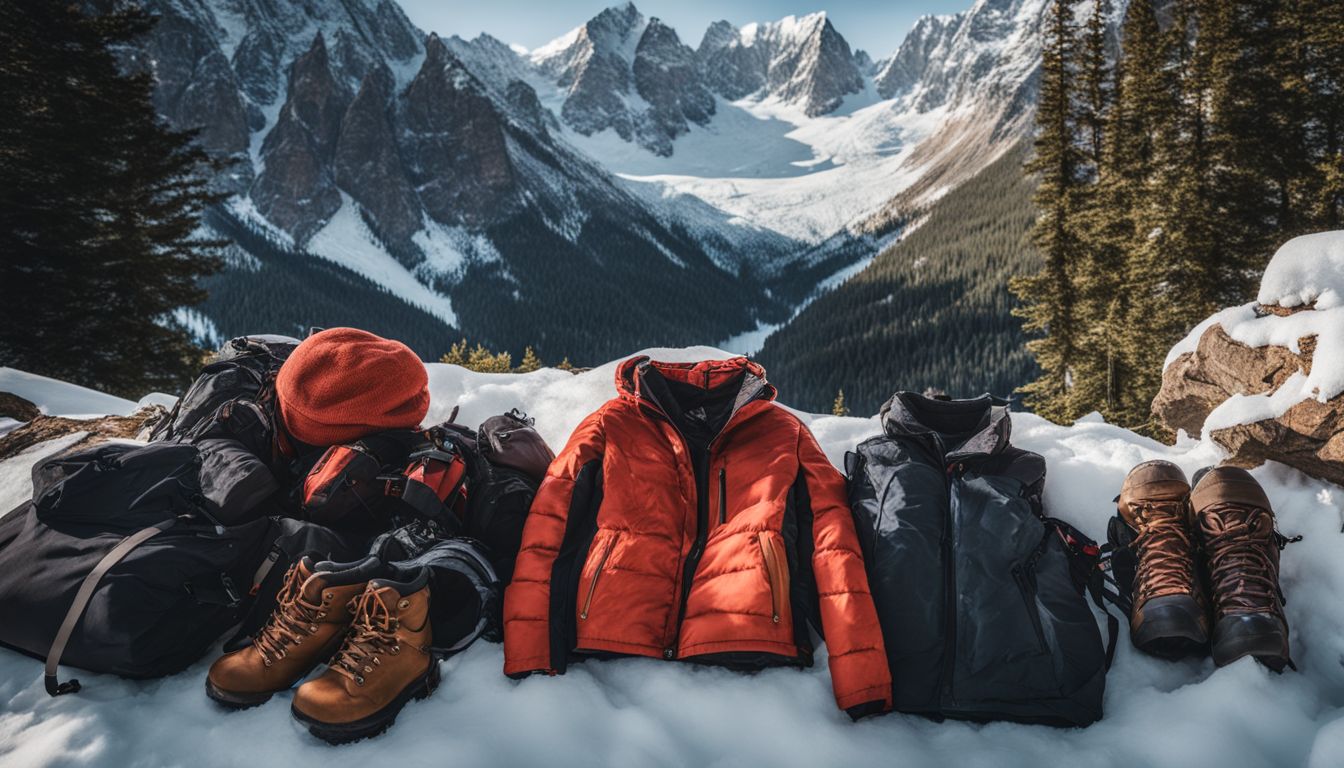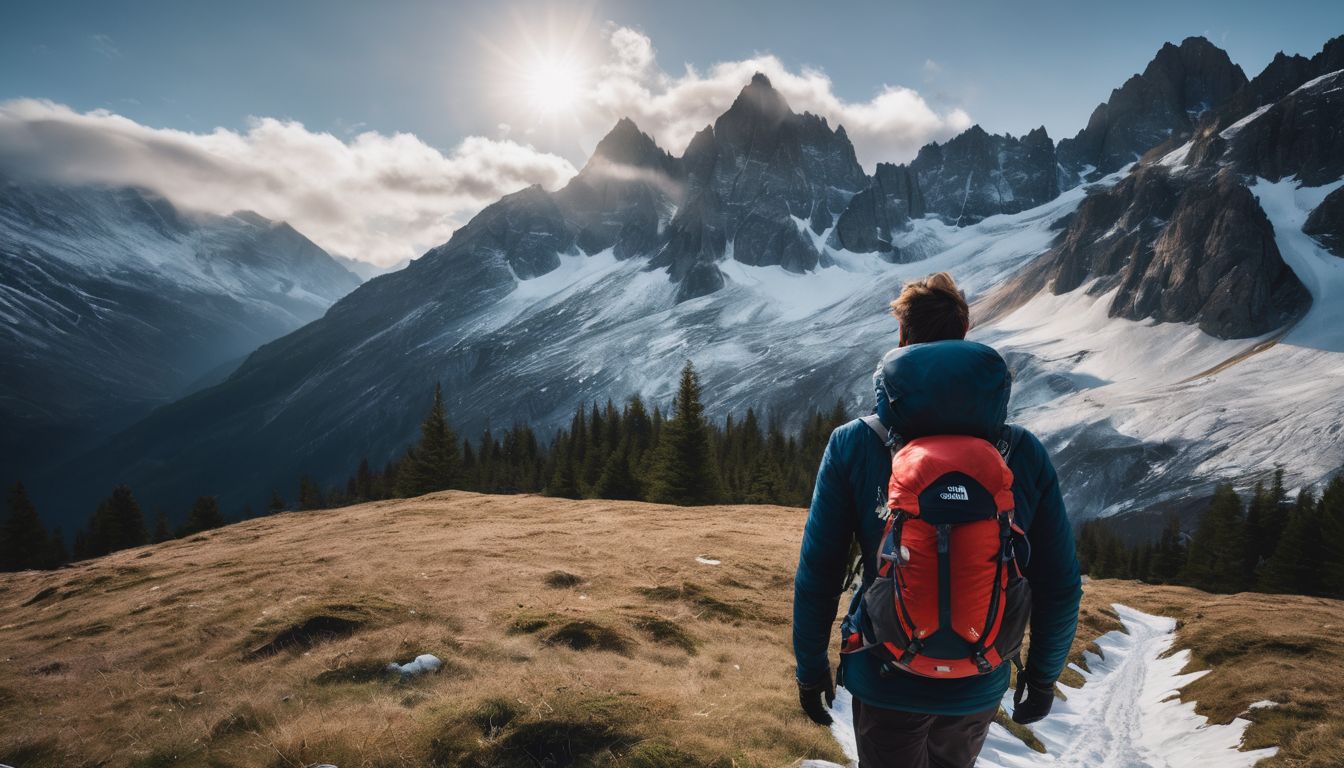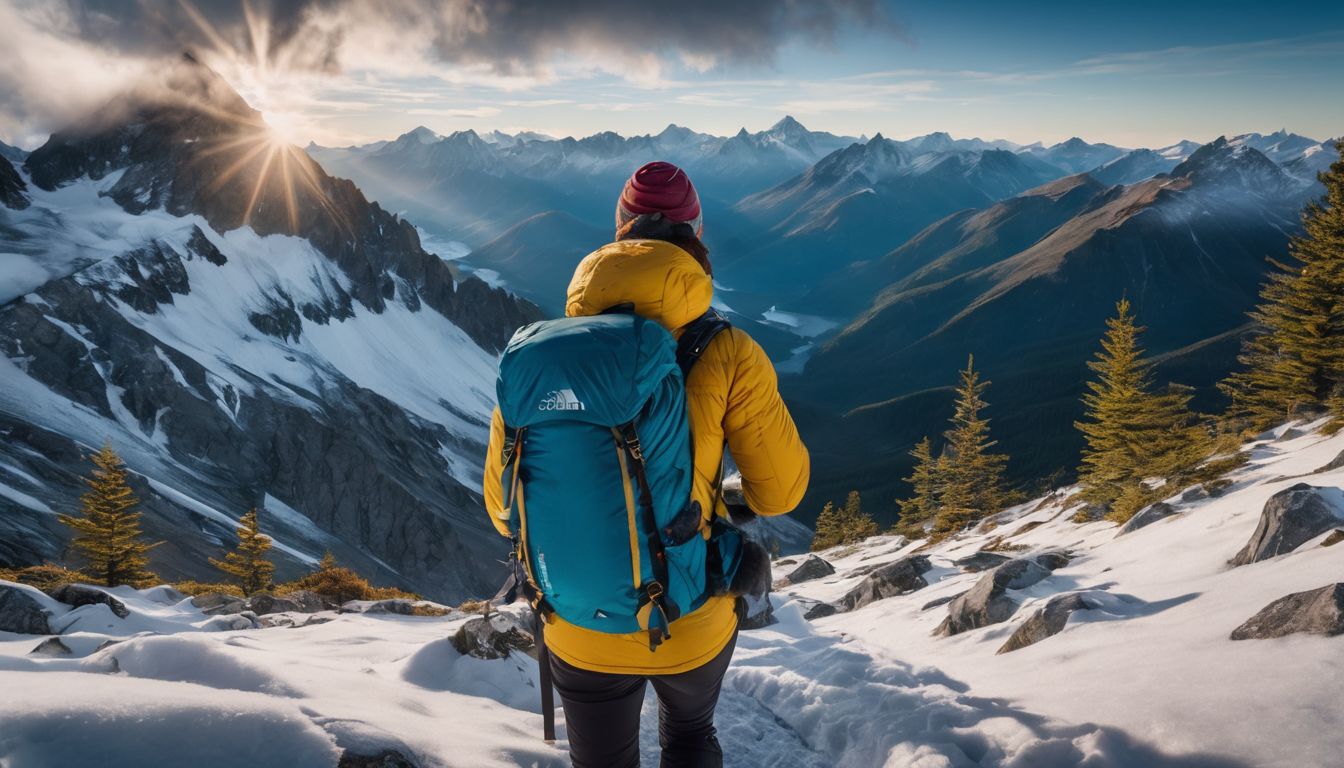Packing for cold weather adventures often leaves even seasoned travelers scratching their heads. Will you have enough room for all that bulky gear? As a veteran of many frosty treks, I’m here to assure you that with the right techniques, packing smart and light isn’t just possible—it’s simple.
Having navigated through icy landscapes and braved snow-capped peaks, my insights are shaped by real-world experiences in some of the harshest winter environments.
Many overlook the importance of choosing functional layers that work together to seal in warmth without sacrificing mobility or comfort. The key lies in understanding not just what to pack, but how to pack it efficiently; something this article will explore thoroughly.
You’ll soon discover how strategic planning transforms your rucksack into an organized vault keeping cold at bay. Keep reading – mastering cold-weather packing awaits!
Key Takeaways
- Mastering the art of layering is crucial for cold weather rucksack packing. Base layers provide warmth, mid-layers offer insulation, and outer layers protect against wind and moisture.
- When selecting a rucksack for cold – weather travel, consider factors like space, compression, durability, and weather resistance to ensure organization and protection of gear from harsh elements.
- Proper weight distribution in your rucksack is essential; it should not exceed 20% of your total body weight. Align the heaviest items close to the middle of your back for efficient weight distribution.
- Essential gear such as lightweight packable down jackets, waterproof insulated boots, gloves, hats, scarves are vital for staying warm and comfortable during cold weather adventures.
Mastering the Art of Layering

To stay warm and comfortable in cold weather, mastering the art of layering is essential. Base layers provide warmth, mid-layers offer insulation, and outer layers protect against wind and moisture.
Paying attention to these details will ensure you’re well-prepared for your cold-weather adventure.
Base Layers for Warmth
Base layers are your secret weapon against the cold. They sit right next to your skin and work hard to keep you warm by trapping heat and moving sweat away from your body. Think of them like a cozy, invisible hug that keeps you warm all day long! Merino wool is a superhero in the world of base layers because it’s really good at controlling temperature.
It helps you stay warm when it’s cold out and cool when things start heating up.
Picking the right fit is key. Base layers should be snug but never too tight – just like a second skin. This way, they can do their job without getting in your way or making you feel stuffed inside your clothes.
Plus, choosing the proper weight for these layers is important too; lightweight ones are great for mild conditions while heavier options suit freezing adventures.
Now that we’ve got warming up covered with our trusty base layers let’s talk about mid-layers for insulation — another layer of defense to lock-in warmth!
Mid Layers for Insulation
Mid layers are your secret weapon against the cold. Think of them like a warm hug in the form of wool sweaters that trap heat and keep you cozy. You want these layers to be snug enough to hold in warmth, but also loose enough so air can still move around.
Fleece jackets shine as mid-layers because they’re masters at insulation. They work hard to keep your body’s heat close without making you too hot when you’re on the move. And since they are breathable, they help stop sweat from getting trapped.
Next up after choosing your mid-layer is picking out a tough outer layer for protection. This is what stands between you and the icy winds or rain on your adventure.
Outer Layers for Protection
After picking the right mid layers, it’s time to think about your shield from harsh weather. Your outer layer is like armor against snow, wind, and rain. It’s made of fabrics that keep water out but let your body breathe so you don’t get too sweaty.
Look for coats with taped seams because they stop water from sneaking in.
Your waterproof jacket should fit over all your other clothes comfortably. Make sure it’s tough enough to handle whatever Mother Nature throws at you. A good one will be your top guard when you’re facing icy winds or wet conditions on winter hikes.
This layer keeps you dry and snug, so finding a strong one means staying warmer longer.while enjoying the snowy outdoors.
Selecting a Cold-Weather Rucksack

When it comes to selecting a rucksack for cold-weather travel, it’s important to consider factors like space, compression, durability, and weather resistance. The right rucksack will help you stay organized and protect your gear from the elements during winter adventures.
Space and Compression
Compression bags and packing cubes are indispensable tools for creating space in a cold-weather rucksack. By using these items, you can significantly reduce the volume of your clothing and gear, allowing for more efficient use of space.
It’s important to prioritize compressible items that won’t lose warmth or functionality when packed tightly, such as down jackets and sleeping bags. With waterproof compression sacks, you can ensure that your belongings stay dry even in harsh weather conditions.
When preparing for cold weather travel, it’s crucial to pack light while making the most of available space. Compression bags offer an effective solution for minimizing bulk and maximizing capacity in your rucksack so that you can bring along everything you need without feeling weighed down or encumbered by bulky gear.
Durability and Weather Resistance
When choosing a rucksack for cold-weather adventures, it’s crucial to prioritize durability and weather resistance. Look for rucksacks made of robust materials designed to withstand harsh winter conditions.
Ensure the rucksack features sturdy zippers, reinforced stitching, and water-resistant fabric to protect your gear from snow, rain, and wind. Additionally, adjustable straps and ergonomic design are essential for optimal comfort during long treks in challenging weather.
Durability is key for withstanding the rigors of cold-weather camping while weather resistance ensures protection of gear and belongings. A rucksack built with these features not only provides peace of mind but also enhances the overall experience by keeping essential supplies secure amidst unpredictable outdoor elements.
Understanding the importance of durability and weather resistance when selecting a cold-weather rucksack sets the foundation for a comfortable and worry-free outdoor journey. Now let’s delve into mastering weight distribution basics.
Understanding Rucksack Weight Distribution Basics
To ensure proper weight distribution, your backpack should not weigh more than 20% of your total body weight. Align the heaviest items as close to the middle of your back as possible.
This allows the pack to distribute the weight efficiently to your hips. Proper weight distribution is crucial for preventing strain and discomfort during long periods of carrying the pack.
In cold weather, this becomes even more important because it can impact balance and stability on slippery or icy terrain. Therefore, understanding how to distribute the weight in your rucksack properly is essential for both backpacking and travel in cold conditions.
Remember that aligning heavy items towards the middle of your back will help maintain better balance and reduce strain when navigating through snow or icy trails.
Essential Cold Weather Gear
When it comes to cold weather packing, having the right gear is essential for staying warm and comfortable. From lightweight, packable down jackets to waterproof, insulated boots and accessories like gloves, hats, and scarves – being well-prepared is key to a successful winter journey.
So buckle up and continue reading to discover more about essential gear for cold weather rucksack packing.
Lightweight, Packable Down Jacket
A packable down jacket is a travel essential for staying warm in cold weather. It’s lightweight and easy to pack, making it perfect for winter travels. Packable down jackets are favored for one-bag travel due to their versatility and warmth-to-weight ratio.
The generous insulation of goose down or synthetic materials in cold-weather bags ensures superior warmth without adding bulk to your luggage.
When traveling in colder climates, the secret to packing light lies in including a puffy insulated jacket – warm, ultra-lightweight, and versatile. A packable down jacket is recommended as part of essential cold-weather gear for its ability to provide crucial warmth while remaining easy to pack and carry.
Waterproof, Insulated Boots
Waterproof and insulated boots are a must for venturing into cold weather. They keep your feet warm and dry, protecting them from harsh conditions. These boots provide essential insulation to prevent your feet from getting too cold, ensuring comfort during your outdoor adventures in icy terrains.
Icelanders stress the significance of wearing appropriate clothing for winter weather, including waterproof and insulated boots. When packing for cold weather trips, it’s crucial to choose footwear that can withstand the elements while keeping you warm and cozy.
Opting for “soft” insulated winter hiking boots is popular among many outdoor enthusiasts as they are compatible with microspikes, snowshoes, and crampons – perfect companions for exploring wintry landscapes in style.
Accessories: Gloves, Hats, and Scarves
Cold weather demands the right accessories for warmth. Gloves, hats, and scarves are crucial in keeping you cozy. These items don’t take up much space but make a big difference in cold climates.
Donning warm gloves and a hat makes tackling winter adventures comfortable. In chilly Europe, sunglasses, mittens or gloves, and a wool hat that covers your ears are vital for staying snug during travels.
When hitting the trails in winter, pack essentials like gloves and a warm scarf to keep frost at bay.
Packing Techniques for Bulky Items
To efficiently pack bulky items in your rucksack for cold weather travel, utilize compression bags to minimize space and maximize organization. Additionally, consider wearing the bulkiest items while traveling to reduce the strain on your backpack.
Utilizing Compression Bags
Compression bags are a handy tool for efficiently packing bulky winter clothing in your rucksack. These plastic bags come in various sizes, from small to 2XL, providing options for accommodating different items.
The process is simple: stuff your bulkier clothes into the bag and seal it; then use pressure from your hands or knees to compress the contents. This maximizes space in your rucksack, allowing you to fit more clothing for cold-weather travel.
By utilizing compression bags, travelers can save valuable space in their carry-on luggage while ensuring they have all the necessary gear for their winter adventure. It’s an essential step towards efficient packing and lightening the load when embarking on a cold-weather journey.
Wearing Bulkiest Items While Traveling
Wearing your bulkiest items, like a thick coat or bulky boots, while traveling can help you save space in your bag. This leaves more room for other essentials. Plus, it keeps you warm during transit or if the weather suddenly changes.
Remember that layering smartly is key to staying comfortable while wearing bulky winter clothing. Opt for thinner but insulating materials for your outerwear and make sure they are easy to put on and take off when you are on the move.
As you pack for cold weather, think about how wearing some of your bulkiest gear can create space in your rucksack. It’s a practical way to manage limited packing space and ensure that you stay cozy during any part of your journey.
Conclusion
In summary, mastering the art of layering is essential for cold weather rucksack packing. The strategies provided are practical and efficient, ensuring a comfortable and enjoyable trip.
How will you apply these tips to your next cold-weather adventure? By understanding the importance of proper gear selection and packing techniques, you can significantly improve your winter travel experience.
Remember, adequate preparation leads to successful and memorable outdoor adventures. So, what are you waiting for? Embrace the cold with confidence!
FAQs
1. What should I pack in my rucksack for cold weather camping?
For winter camping, pack a sleeping pad and a cookset for hot food, bring a backpacking stove to cook, and include hand warmers to keep you warm.
2. Can I stay connected while snowshoeing in the cold?
Yes! Pack your digital camera or GoPro for pictures, use T-Mobile or another service with good coverage, and consider using NordVPN for safe wifi connections.
3. How do I choose clothes for packing in cold weather?
Wear layers like socks made for being active, sweatshirts over sweater-dresses, water-resistant ankle boots, and always remember oral care items!
4. Are there any gear tips to help with sustainable travel during cold trips?
Choose gear that lasts long like high-quality lenses from Carl Zeiss in cameras; carry power banks instead of many batteries; pick tough travel gear.
5. What are some important little things not to forget when packing my bag?
Don’t miss out on putting hand sanitizer in your bag! And if you want snacks on your trip – think about bringing cookies too!
6. How can I protect myself financially when traveling through winter landscapes?
Make sure you have your debit card ready just in case but also look into ways like having affiliate links that help earn money which can lower how much you spend overall (this is called reducing bounce rate).

